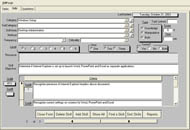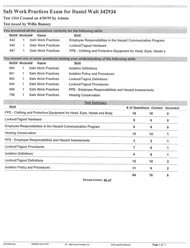|
Skill
definitions
SkillForge
manages extensive catalogues of skill objectives. Skill objectives
represent the competencies required to perform a group of tasks.
Input
screens permit linking any number of performance criteria to skills,
to make performance expectations very clear. In addition, the program
links information that trainers and certifiers can use in their
work—the type of skill, verification method and whether a skill
can be evaluated with a written test or by observation.
Skill testing and assessment
SkillForge permits companies to define the type
of skill verification they require for each skill. This information
is published, along with the skill definitions, in skill qualification
guides . The guide lets individuals self-assess on skill sets and
request available training. The guide also lets individuals see
whether testing, observation or both will be used for skill verification.
A comprehensive testing module permits companies to enter any number
of questions for each skill and produce, score and manage individualized
double-randomized tests for each person.
 SKILL
DEFINITION SCREEN. Click on the image to see a full-size page.
SKILL
DEFINITION SCREEN. Click on the image to see a full-size page. |
Validity
of work expectations
Validity of work expectations is an important human resources
concern. Competency tests and skill definitions created by other
means often require rigorous validation because they are externally
imposed. Repertoire processes build tasks and skills from grass-roots
work definitions provided by competent performers. The program
identifies the tasks in which each skill is discovered to verify
validity. |
Task-
and skill-based output
From task and skill information, the system creates a number of
tools. These tools represent a comprehensive definition of a company’s
work.
Skill
Qualification Guides
One
of the most-used tools is the Skill Qualification Guide. The
skill qualification guide lists all skills and criteria in a
given skill area and level. The skills are grouped by modules.
(For full information about module development, see training
section, below.) Additional information in a Guide enables an
employee to perform a self-assessment of competence and locate
any necessary training. A guide also indicates what kind of
verification to expect. As self-assessment and verifications
are completed, the employee and subject expert can record those
completions. Making employees responsible for their personal
development plan and tracking reduces administrative overhead
and increases responsibility. |

A
typical SKILL CERTIFICATION GUIDE page. Click on the image to
see a full-size page. |
The
skills certification and training records module simplifies record
keeping and tracks advancement
The
Skills Certification and Testing Module holds complete employee
contact information. Certifiers are able to enter certification
and testing completions on a module-by-module basis. The program
can also be set up to record training completions. In most cases
though, basing competence on skill verification rather than training
completion greatly reduces the training load.
|
Testing
feedback
SkillForge tests are meaningful. For each skill, the system
stores multiple banks of questions. Each individualized test
is doubly randomized, first by the bank selected to test each
skill and second, by complete randomization of the order of
questions.
Tests
provide feedback. Each test result report lists each skill
on which the individual missed one or more questions. To see
a sample report, click on the image to the right. |

A
typical TEST RESULTS REPORT page. Click on the image to see
a full-size page. |
 The
level at which certification and testing are tracked is completely
customizable. Employee status can be viewed on screen or in reports.
The module’s functions can also be expanded to allow employee critiques
of both training and certification. It also permits graphic modeling
of an employee’s job progression, with a tabular display and in
a block diagram. The illustration to the right shows the module’s
overall work flow. The
level at which certification and testing are tracked is completely
customizable. Employee status can be viewed on screen or in reports.
The module’s functions can also be expanded to allow employee critiques
of both training and certification. It also permits graphic modeling
of an employee’s job progression, with a tabular display and in
a block diagram. The illustration to the right shows the module’s
overall work flow.
|






 The
level at which certification and testing are tracked is completely
customizable. Employee status can be viewed on screen or in reports.
The module’s functions can also be expanded to allow employee critiques
of both training and certification. It also permits graphic modeling
of an employee’s job progression, with a tabular display and in
a block diagram. The illustration to the right shows the module’s
overall work flow.
The
level at which certification and testing are tracked is completely
customizable. Employee status can be viewed on screen or in reports.
The module’s functions can also be expanded to allow employee critiques
of both training and certification. It also permits graphic modeling
of an employee’s job progression, with a tabular display and in
a block diagram. The illustration to the right shows the module’s
overall work flow.